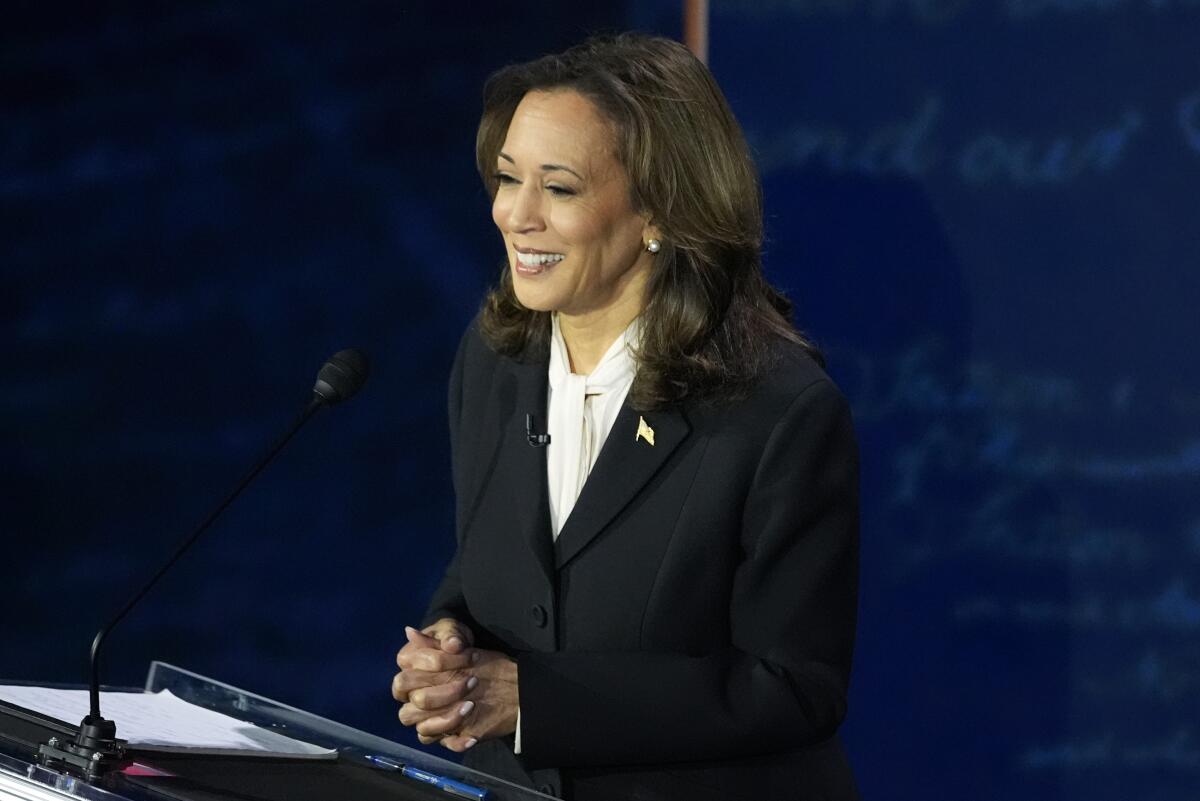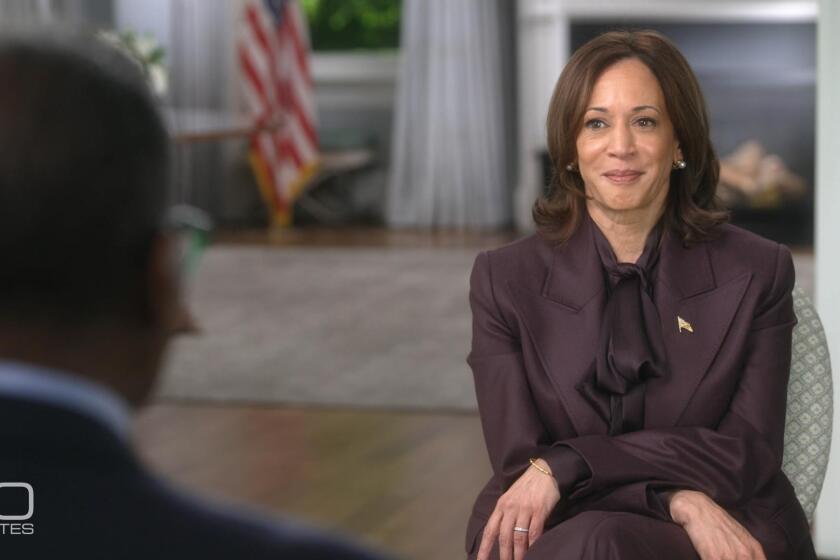Post-debate, how much progress will Harris make in the polls?

- Share via
WASHINGTON — The 1980 presidential race remained neck-and-neck into its final week, as a crucial swath of voters weighed their dismay with President Carter against their fears about his challenger, Ronald Reagan.
One week before election day, the two met for their only televised debate. Viewers found Reagan personable, reassuring and presidential. Polls tracked a surge in his direction over the final weekend, and he won handily.
Ever since, candidates in tight races have hoped to emulate what Reagan did.
None has.
You're reading the L.A. Times Politics newsletter
Anita Chabria and David Lauter bring insights into legislation, politics and policy from California and beyond. In your inbox three times per week.
You may occasionally receive promotional content from the Los Angeles Times.
Vice President Kamala Harris probably didn’t quite get that far with this week’s debate. Among otherfactors, she’s facing an electorate that is far more partisan than the voters of 1980, making big swings much harder.
Harris did, however, make important progress in two critical areas — reminding voters what they dislike about Trump and appearing presidential.
We won’t know how much ground Harris gained for a couple more days — until results come in from high-quality polls fielded after the debate.
But quick-turnaround surveys have already shown significant movement toward the Democrat.
A shift of 2 or 3 points in her direction once all the latest polling is accounted for would be a significant step for Harris, giving her a slight edge as the campaign moves into its final phase. A larger move in polls would mark a major victory.
By contrast, if the polls show no movement toward Harris after a debate that most viewers said she won, that would indicate a more stubborn resistance to her campaign among swing voters, one that could be hard to surmount.
Boosting Trump’s negatives
A key indicator to watch will be the share of voters who have an unfavorable opinion of Trump.
The former president continues to have a negative public image, as he has throughout his political career. That puts him at a disadvantage to Harris — voters are almost equally split between positive and negative views of her.
But Trump’s numbers have improved this year, and the share seeing him negatively is now lower than it ever was during his presidency.
Analysts offer several possible explanations: Nostalgia’s rosy glow makes almost all presidents more popular after they leave office; that effect may have been especially sharp this time because the steep inflation of 2021 and 2022 caused voters to fondly recall the good economy of Trump’s first three years in office; and younger voters may have only vague memories of Trump controversies that took place in their teenage years.
Whatever the reason, the share of Americans with a favorable view of Trump — 43% is at its highest point, according to the average of polls compiled by the FiveThirtyEight website. The unfavorable share, 53%, is at a corresponding low.
When President Biden remained in the race, his campaign invested tens of millions of dollars in trying to make Trump’s image more unfavorable. They failed, and overcoming Trump nostalgia continues as a major Democratic priority.
During the debate, Harris spent considerable time reminding voters about Trump’s personal negatives — his felony conviction, his role in the Jan. 6, 2021, attack on the Capitol, the large number of former Trump administration officials who have refused to support him again — and the unpopular policies that he’s backed, starting with overturning Roe vs. Wade.
The main targets of that effort are voters whose feelings about Trump fall onto the middle of the scale, neither intensely negative nor strongly positive.
About a quarter of the likely electorate falls into that group, according to a New York Times/Siena College poll released this week. That poll indicated 29% of likely voters with a very favorable image of Trump and 44% with a very unfavorable one. The 25% in between split, with 17% having a somewhat favorable impression of Trump and 8% somewhat unfavorable.
Another question on the poll, one which asked if Trump had “ever said anything that you found offensive,” sheds additional light on the voters Harris was potentially reaching with her attacks.
The largest group, 43%, said Trump had “recently” offended them. Harris already has the backing of the vast majority of them.
An additional 29% said he had never said anything offensive, and they make up Trump’s loyal base.
In between, 27% said Trump had offended them, but “not recently.” That’s the group potentially open to persuasion, and it’s why it was effective for Harris to goad Trump into wild accusations, like his statement that immigrants in a small Ohio city are “eating the dogs — the people that came in. They’re eating the cats. They’re eating — they’re eating the pets of the people that live there.”
Ohio officials and multiple media outlets have found no evidence to support Trump’s claim, though there have been subsequent reports of immigrants being harassed and threatened in the area as a result of the false allegation.
We don’t yet know how many voters were turned off by that sort of rhetoric, but it’s clear that Harris stands to gain to the extent that voters move from the “yes, but not recently” category to seeing Trump as currently offensive.
‘Loss aversion’
Michael Podhorzer, the former political director for the AFL-CIO and now a political analyst, has frequently said that “there is an anti-MAGA majority in America, but not necessarily a pro-Democratic majority.”
His point is that the voters Democrats need in order to win a majority are “driven by loss aversion.” They fear Trump and his allies will take away rights and benefits they currently rely on, but they won’t necessarily turn out to vote to support new Democratic priorities the way more partisan voters will.
Those voters, who are predominantly younger and politically somewhat disengaged, will show up to vote when they’re reminded of the stakes and see a realistic scenario in which voting will make a difference, Podhorzer argues.
The 2020 midterm elections very much followed that pattern — voters turned out for Democratic candidates in states such as Michigan and Pennsylvania, where abortion rights were hotly contested and either side might win.
They were less likely to show up in states such as New York or California, where the stakes seemed lower, or in Texas, where there was little prospect of any abortion rights victory.
Harris played heavily into voters’ loss aversion during the debate, focusing on Trump’s repeated efforts to repeal the Affordable Care Act and his role in ending Roe vs. Wade’s guarantee of nationwide abortion rights.
As he did at other points in the debate, Trump played into Harris’ hands. On healthcare, he suggested he could be open to another effort to repeal the ACA while also saying that despite nine years of promising an alternative, he still had only “concepts of a plan.”
On abortion, Trump has persistently tried to fuzz up his position. Like many Republicans, he fears alienating the party’s fervently antiabortion wing but also knows that abortion bans have proved highly unpopular.
In the debate, he insisted that he doesn’t support a nationwide ban, but pointedly refused to say he would use his veto if congressional Republicans passed one.
“We don’t have to discuss it,” he said twice.
Expect to see that line, as well as “concepts of a plan,” featured in Democratic advertising in the campaign’s closing weeks.
The news cycle turns
Democrats have been cheered by how Harris performed, but there’s a good reason that no fall debate since 1980 has permanently shifted a campaign — the news cycle keeps moving, other events come along and memories fade.
Already, major events loom ahead, starting with the possibility of a government shutdown at the end of this month.
Members of the right-wing House Freedom Caucus have said they won’t vote for a bill to fund government agencies for the new fiscal year unless it includes a measure they’ve pushed that aims to block noncitizens from voting.
Since federal law already bars noncitizens from voting, Democrats suspect the Freedom Caucus of ulterior motives. The party’s election lawyers say provisions in the GOP bill could serve as pretexts to undermine this year’s election.
Trump has egged on the Freedom Caucus, writing on his Truth Social site that they should refuse to vote for the government money bill “in any way, shape or form” unless they “get absolute assurances.”
On Wednesday, House Speaker Mike Johnson (R-La.) had to pull the bill from the floor because he lacked votes to pass it.
Government shutdowns are always unpopular, and one just a few weeks before the election could seriously hurt Republicans in swing districts.
For that reason, Johnson and other GOP leaders will try hard to reach a compromise with Democrats to extend the deadline until later in the year.
But Trump’s role in supporting the shutdown will complicate any deal-making, and, as in any game of chicken, the possibility of a collision can’t be ruled out.
How a shutdown might affect the presidential race is hard to say, but the possibility is a reminder that by the time most voters cast their ballots, this week’s debate may be a distant memory.
What else you should be reading
Poll of the week: More U.S. Latinos are aware of the word Latinx, but only 4% use it.
The Saturday read: Inside the Trump campaign’s plan to win Arizona
The L.A. Times special: Diamonds, pearls and 15th century art: Dianne Feinstein’s possessions will be auctioned in L.A.
—
Was this newsletter forwarded to you? Sign up here to get it in your inbox.
Get the L.A. Times Politics newsletter
Deeply reported insights into legislation, politics and policy from Sacramento, Washington and beyond. In your inbox twice per week.
You may occasionally receive promotional content from the Los Angeles Times.




